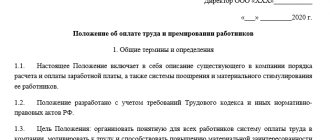Downloads: 351
I approve
CEO
_____________________
"__" ___________________ 2005
EMPLOYEE WAGE REGULATIONS
- In salary means remuneration paid to an employee for the high-quality and timely performance of his functional and job responsibilities as provided for in the job description and internal regulations of the company.
- In this case, the salary includes the following components: a constant value , which is fixed and unchanged during the period of validity of this provision, and a variable value (executive).
- A bonus is understood as a component of remuneration in the form of a one-time payment of a sum of money based on the results of the company’s activities for the calendar year.
Why do you need a wage clause?
The Regulations on the Remuneration of Workers (hereinafter referred to as the Regulations on Labor Regulations) are the rules governing the procedures for calculating and paying wages at the enterprise.
They reflect the remuneration system used in the business entity, which makes up the salary - additional payments, bonuses, allowances.
With the help of this act, the salary of each employee is determined in the employment contract. For example, you can not describe what bonuses are due to those working at the enterprise, but make a reference to the norms of the Regulations on Labor Protection.
This act adapts the current legal norms to the working conditions existing in the company, with the help of which the peculiarities of payment for the activities of each enterprise are taken into account. This eliminates or helps resolve many disputes with the company’s employees.
Attention! During inspections by regulatory authorities, the inspector often requests this document in order to understand what kind of remuneration system there should be, and compares the provisions of this document with existing reality.
Wage
The second section may be called “Salaries”. It should list the procedure and terms for payment of wages, indicate the wage system, for example, time-based or piece-rate; minimum salary; the amount of income for certain categories of employees depending on the position held or job functions performed; tariff rates (if the salary will be determined by them); limits on cash payments in kind.
The law does not impose specific requirements for the structure and content of the salary regulations, since this document is not mandatory. The purpose of the paper is to establish the procedure for paying money to all employees.
And do not forget: the Labor Code provides that the payment of money in bonds, coupons, in the form of promissory notes, receipts, as well as in the form of alcoholic beverages, narcotic, poisonous, harmful and other toxic substances, weapons, ammunition and other items in respect of which prohibitions or restrictions on their free circulation are not allowed.
And one more thing: the monthly salary of an employee who has fully worked for this period and fulfilled the standards cannot be lower than the minimum wage. Currently, the minimum wage is 5,554 rubles.
Who should make the position
Local regulations on the calculation and payment of wages are necessary for business entities if they have labor contracts with employees.
Regulations on remuneration of employees are not necessarily developed at the enterprise. This is primarily due to the fact that the issues discussed in it may be reflected in other regulations at the enterprise - Collective Agreement, Internal Regulations, etc.
According to the Labor Code of the Russian Federation, the very fact of specifying the current legal norms to the specific operating conditions of an enterprise should be mandatory, since standards often establish several options for action in certain conditions. This is especially important when regulating issues of remuneration for periods that differ from normal working conditions.
Therefore, which act will reflect the rules for calculating wages is decided by the management of the enterprise independently.
Attention! Combining regulations in one document is typical for small businesses. In practice, for example, the Labor Regulations are often combined with the rules governing the calculation of all types of bonuses. Then this document is called the Regulations on remuneration and bonuses for employees.
The larger the business entity, the more it has its own standards. At the same time, it is imperative to ensure that they are consistent and do not contradict each other. Many issues regarding the regulation of wages can be immediately addressed in several provisions of the enterprise. If there is any discrepancy among them, this will lead to their invalidation.
You might be interested in:
Explanatory note about an employee’s failure to fulfill official duties: how to write correctly
Local regulations at the enterprise are developed by specialists from the economic and legal departments. The project is submitted for approval to representatives of trade union bodies before approval.
What should a provision on remuneration of workers contain?
The regulations on remuneration may include several sections designed to fully disclose the principles of calculation and payment of various amounts of money to employees of the enterprise.
General provisions
This includes general information about the contents of this document. For example, here you can indicate multiple tariff rates, salaries, compensation and bonus payments that can be paid to employees. Additionally, existing systems for determining additional payments and allowances can be included in this section.
Remuneration system

This section should contain detailed information about what kind of payments at the enterprise relate to wages.
This may include:
- Cover part;
- Awards. If the company has developed and put into effect a separate document responsible for determining and paying bonuses, then in the Labor Regulations it is enough to mention that bonuses are accrued and make a reference to the necessary internal act;
- Personal accruals (for example, the administration can make an additional payment for the level of education, continuous period of work at the company, etc.);
- Additional payments that are assigned due to a certain work schedule or special working conditions (long working hours, hazardous conditions in the workplace, etc.);
- Additional payments for after-hours hours - going to the workplace at night, a holiday or a day off. In this case, both the composition of such payment and its size can be established;
- Payment for working time for downtime, divided into the various reasons why it arose;
- Any kind of additional benefits that a company wants to pay to its employees.
It is necessary to pay special attention to the drafting of this section, since it is this section that will establish:
- What amounts should be paid to the company’s employees and for what?
- What accruals can be included in the calculation of average earnings when determining the amounts of vacation pay, sick leave, business trips, etc.;
- Based on what payments the payment for weekends, holidays, night hours will be calculated - according to the law, the employer must only use the salary;
- Which payments will be subject to social contributions, and which ones can be taken into account when determining income tax.
Important! For payments that the administration must make to its employees under special working conditions (for example, during overtime work), a separate section can be drawn up indicating the procedure for performing the calculation.
The procedure for indexing wages
Regular indexation is an obligation for the administration, not a right at will. The regulations on the remuneration of workers must include information about the frequency with which indexation is carried out, as well as on the basis of what information the coefficient is determined. It is possible to establish the exact value of the indexation coefficient.
You might be interested in:
Order on approval of bonus regulations: how to draw up correctly
Material aid
In this section, it is necessary to mention as fully as possible all types of material payments that the administration can issue as assistance to its employees. This could be the birth of a child, marriage, or the death of a relative.
It is also necessary to directly indicate the amount that will be paid in a given situation. This amount can be indicated directly, or the situation on the basis of which it will be determined can be determined (for example, the amount of payment will be set by the director by issuing an order).
Here you can indicate whether financial assistance payments will be taken into account when determining average earnings.
Procedure for payment of wages
When preparing this section, special attention must be paid to ensure that its data does not conflict with the provisions of the law.
In particular, salaries must be paid in two parts, with no more than 15 days between them.
In this section you need to set the dates when the advance payment, the rest of the salary, vacation pay and other payments will be issued. The process of transferring the issue if the specified day falls on a holiday or weekend.
Attention! In the document, you can set the dates for payment of salaries to employees of different departments (in this case, the payment requirements defined by law must also be observed).
In this section, you can also mention the procedure for working with deductions, how exactly and in what time frames pay slips are issued, how wages are paid - in cash, by card, etc.
Types of cash incentives
The regulation includes an important section on monetary incentives for employees. It must indicate all current types of compensation and allowances with a specific indication of their amounts and payment procedure (in which cases they are applied and in what amount). The reward system may include the provision of free trips, tickets, etc. - then information about this is included in the document. In the “Financial assistance” section you need to indicate a complete list of cases when the administration provides financial support to its employees. This list usually includes: the birth of a child, the loss of a close relative, marriage. We can also talk about the case of individual assistance based on specific circumstances.
Additional items can be added if desired. If you decide to use a sample employee remuneration regulation 2021 prepared by experts, you should carefully double-check it for compliance with the procedures of your organization and rework it: for example, in some places there are allowances, and in others there are not. Some set a limit on the total amount of additional payments, others do not limit them.
It is necessary to indicate the specific amount of financial assistance or the method for determining it. For example, the director establishes it by his own decision in a separate order based on the submission of the employee’s immediate supervisor. This paragraph also separately indicates whether amounts of financial assistance will be taken into account when calculating average earnings.
Procedure for approval and amendment of regulations
The regulation on remuneration of employees, like other internal acts of the enterprise, can be approved in several ways:
- By affixing the stamp “I approve” on the act itself, with a record of the position of the responsible person, his full name. and personal signature;
- An order is issued to approve the wage regulations - a separate order in writing.
Attention! After the regulation has been adopted, all employees registered at the enterprise must be familiarized with it against signature. This can be done by using familiarization sheets, or by making notes in a special journal.
When changes are made to labor legislation, or with the introduction of new processes at an enterprise, sometimes it becomes necessary to adjust the existing regulations on remuneration.
To do this, the responsible person must submit a memo to the director, on the basis of which the director will give an order to develop a new version of the regulation.
After this, approval of the project, approval of the wage regulations and implementation completely coincides with the process of working on the primary internal act.
Special conditions
The fourth section can be called “Rules for remuneration in special conditions.” It must include a list and amount of additional payments that employees can expect when performing work of various qualifications; when combining professions and performing the duties of temporarily absent specialists; during processing; for work on weekends and holidays, at night. However, we should not forget to indicate the procedure and amount of payment in case of failure to comply with labor standards or downtime. Also in this section you can include provisions on payment during maternity leave, child care, or when an employee retires.








